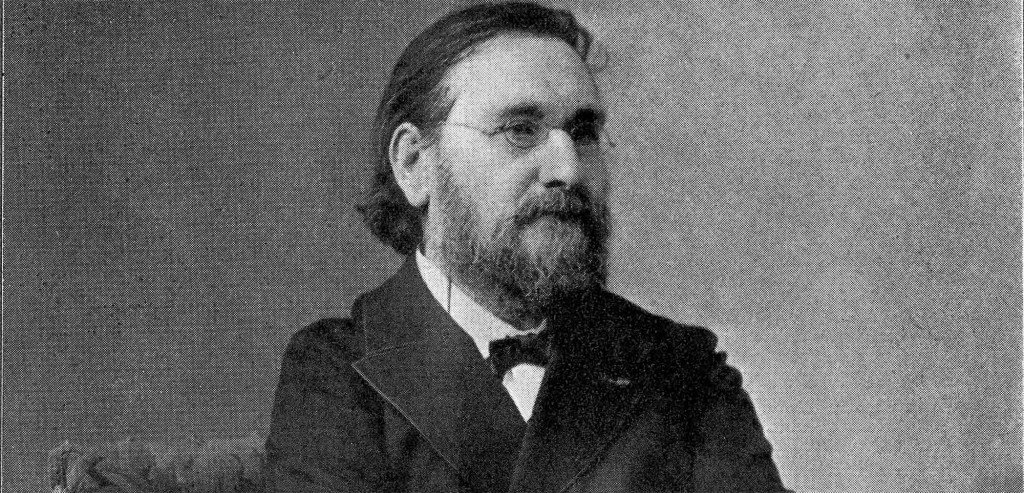Sussanna Czeranko, ND
We might think that acidophilus in the form of capsules and fortified yogurt was a recent 20th century discovery. It’s not. Although, yogurt as a food has been used for many centuries as a medicine, yogurt was first introduced with the scientific rigor of a scientist from the Pasteur Institute. In fact, probiotics were invented in 1907, following the astute observations of the dedicated and outstanding scientist, Elie Metchnikoff. As naturopathic physicians, we consider “dietetics” golden in our treatment plans, and know full well that having a healthy gut is essential for optimum health. Let me introduce you to Metchnikoff, a remarkable scholar and clinician not well known to contemporary naturopathic doctors, but who actually is “regarded [as] the grandfather of modern probiotics.” (Anukam et al, 2007, p.466)
Elie Metchnikoff
Elie Metchnikoff was born with an insatiable curiosity for the living world that surrounded him. When he was just a young man, he was given a microscope which became the catalyst for his life work and would lead him to spend years patiently studying the development and habits of small creatures such as worms, insects, echinoderms, and jelly fish. His observations of these miniscule creatures prompted his discoveries of the behavior of white blood cells in the human body. Eventually, his curiosity and determination to discover the underlying mechanism [phagocytosis] in humans for breaking down harmful bacteria in the body won him the 1908 Nobel Prize for his work.

Born in Russia and being a frail boy, his health was always a constant concern. He was offered an important post in St Petersburg; however, as attractive as the post was, he realized his health would not survive the harsh winters. Instead, he chose the milder climate of Paris, and declined this position to operate the Bacteriological Institute at St Petersburg.
He put his sights on a position at the famed Pasteur Institute. Initially, Metchnikoff worked without pay, just for the opportunity to be pursuing his dream of research. Of this experience Metchnikoff says, “It was in Paris that I succeeded at last in practicing pure Science apart from all politics or any public function. That dream could not have been realized in Russia because of obstacles from above, from below, and from all sides.” (Metchnikoff, 1921, p.136) In the Pasteur Institute, Metchnikoff could realize his goal of bringing together diverse fields of science to collaborate on a single problem. That single problem fell under the heading, “immunity.” At the turn of the 20th century, the leading causes of mortality were infectious diseases such as flu, pneumonia, and tuberculosis. Knowledge of the human immune system was not fully developed until Metchnikoff unraveled the pieces. His contribution to science is manifested powerfully in his work on phagocytosis and his insightful work with probiotics and yogurt.
While examining fish larvae, for example, Metchinkoff’s enthusiasm for new knowledge and for advancing understanding can be seen. He writes, “While studying transparent star fish larvae, a new thought suddenly flashed across my brain. It struck me that similar cells might serve in the defense of the organism against intruders.” (Metchnikoff, 1921, p.117) This was the catalyst for Metchnikoff to formulate what would become his epic work on phagocytosis. Metchnikoff reasoned that perhaps the body mounted the inflammatory response as a curative reaction. He stated, “Inflammation is thus a curative reaction of the organism, and morbid symptoms are no other than the signs of the struggle between the [phagocytes] and the microbes.” (Metchnikoff, 1921, p.118) The prevalent germ theory, entrenched in the belief that germs cause disease, did not exactly fit Metchnikoff’s new discoveries. “Virchow advised [Metchnikoff] to proceed with the greatest prudence in his interpretation, as, he said, the theory of inflammation admitted in contemporary medicine was exactly contrary to Metchnikoff’s.” (Metchnikoff, 1921, p.118-119)
Putrefaction & Gut Microflora
Gut microflora was another area of investigation for Metchnikoff. He developed the theory of intestinal auto-intoxication, which was caused by putrefactive microbes that produced toxic compounds in the gut. These putrefactive substances included phenols, indoles and ammonia, which caused and accelerated the aging process. In 1908, he published his second book, The Prolongation of Life, Optimistic Studies, in which he explores the causes of old age. He saw parallels between aging and the disease processes of auto-intoxication. This book was a continuation of his first, The Nature of Man, Studies in Optimistic Philosophy, in which he introduces his scientific theories of phagocytes and senility.
Metchnikoff’s books were noticed by the early naturopaths, who recognized in his work a kindred spirit. Hereward Carrington, an early naturopath, for instance, wrote a book review of Metchnikoff’s second book in the December 1910 issue of The Naturopath and Herald of Health, presenting his critique of the book’s strengths and weaknesses. Carrington concurs with Metchnikoff’s hypothesis that “the most probable explanation [of the death of animals] is that death comes from poisoning by the secretions of the tissues themselves… If after a time, the secretions are insufficiently eliminated, the tissues must be poisoned.” (Carrington, 1910, p.746) The theory of auto-intoxication was also voiced by Helen Sayr Gray who quotes Dr John Tilden: “Disease is brought about by obstructions and inhibitions of vital processes. The first cause is chronic auto-intoxication from food poisoning… Epidemics and endemics feed upon the autotoxemic and stop where there are none.” (Gray, 1912, p.504)
The naturopaths understood poisons and auto-intoxication in terms of morbid matter. In the words of Henry Lindlahr, “When disease germs find in the human body the necessary conditions for growth and propagation— namely, lowered vitality, and their congenial morbid soil— they multiply very rapidly.” (Lindlahr, 1910, p.131) In regards to intestinal auto-intoxication, Carrington agrees with Metchnikoff: “In what way are the tissues poisoned? Generally speaking, they are poisoned as the result of intestinal putrefaction— this being my own view of the case.” (Carrington, 1910, p.746) Carrington continues, “We must seek for the causes of health and of disease… Of all the measures for prolonging life, Metchnikoff found that rational hygiene was the most efficacious.” (Carrington, 1910, p.745)
We know now that intestinal microbes are essential for human health, yet in the days of Metchnikoff, fellow researchers were divided on this contention.
There was before the naturopaths of this era a question which seemed to have 2 answers, both yes and no: Does the intestine shelter putrefying microbes? (Metchnikoff, 1921, p.197) Metchnikoff had come to the conclusion that the “intestinal flora includes several kinds of putrefying microbes which secrete highly toxic products.” (Metchnikoff, 1921, p.197) At the same time, he cites in his writings the absolute necessity of beneficial intestinal microflora to ensure development and growth.
He states, “In the human intestines under normal conditions, putrefaction occurs only very slightly, or does not occur at all. But in intestinal diseases of children and of adults, the microbes of putrefaction multiply abundantly and produce copious secretions which inflame the intestinal walls.” (Metchnikoff, 1909, p.254) A series of experiments conducted by one of Metchnikoff’s colleagues, M. M. Berthelot and Wollman “established the fact that this intoxication is due to poisons of the aromatic group, such as phenols and indols.” (Metchnikoff, 1921, p.197)
Metchnikoff’s Experiments with Yogurt
Metchnikoff concluded that putrefying microbes which provoke intoxication require an alkaline environment in the intestinal tract. This observation led him to yogurt. The fact that yogurt was eaten by some of the longest-living people in Bulgaria and in parts of Russia caught his attention. What was common among these people was that they all ate copious amounts of fermented milk products such as yogurt. This information influenced his research into sour milk as a food to discourage putrefying microbes. “The scientific rationale for the use of live microbes in the prevention and treatment of infections came to lime-light most transparently in the 20th century when Elie Metchnikoff in 1907 hypothesized that replacing or diminishing the number of ‘putrefactive’ bacteria in the gut with lactic acid bacteria could normalize bowel health and prolong life.” (Anukam et al, 2007, p.466) Metchnikoff explains, “The Bulgarian bacillus taken from yahourth [yogurt] or from soured milk, prepared from pure cultures of lactic microbes, can live in warm temperatures, and, as has been shown is able to take its place in the intestinal flora of man.” (Metchnikoff, 1908, p.180)
Starting from these considerations, he made experiments upon himself and systematically introduced into his diet sour milk carefully prepared with pure cultures of certain lactic bacilli.” (Metchnikoff, 1921, p,198) Metchnikoff used sour milk and also added the Bulgarian bacillus to vegetable and animal broths. John Kellogg took note, commenting, “Metchnikoff’s experiments show that he knew lactic ferment [yogurt] has such a great vitality that it is not only able to live but to flourish in the colon.” (Kellogg, 1908, p.269) Kellogg extolled the virtues of Metchnikoff’s lactic acid, adding, “The new ferment is harmless, so that a person who is suffering from autointoxication may, by introducing into his alimentary canal a sufficient amount of the lactic ferment, drive out the poison-forming germs.” (Kellogg, 1908, p.269) It is not surprising, then, to discover numerous advertisements for acidophilus pills in the naturopathic journals during this period. Kellogg raved about the benefits of lactic ferment capsules:
Each capsule contains ten million or more units. One or two of these capsules taken after each meal in connection with a proper dietary–especially with the free use of such carbohydrates as farinaceous foods, especially rice, and, best of all, malted cereals and maltose in the form of malt extracts or maltose–develop rapidly, and by driving out the invading anaerobes, stop the formation of poisons and give the body an opportunity to clear itself from the accumulated toxins, and thus establish conditions which render recovery possible.
(Kellogg, 1908, p.270)
Metchnikoff worked among scientists who tightly held onto the germ theories of their day, and he enjoyed their collegial collaborations. Although his theories coincided with many of the naturopathic ones of the time, Metchnikoff and naturopaths were divided in their stance on a raw vegan diet and Fletcherism. He remained true to his scientific roots, and was convinced that raw fruits and vegetables were contaminated with harmful germs. He also considered the practice of chewing and mastication promoted by Fletcher to be harmful, commenting, “[it is] quite harmful to chew the food too long only after it has been kept in the mouth for a considerable time.” (Metchnikoff, 1908, p.159)
Certain bacteria found in the intestines “produce poisons (phenol and indol) which are reabsorbed by the normal intestinal walls which provoke arteriosclerosis and other lesions.” (Metchnikoff, 1921, p.206) Metchnikoff determined that “an exclusively vegetarian or carnivorous diet increases [the production of these toxins], while a mixed diet reduces it.” (Metchnikoff, 1921, p.206) Metchnikoff experimented with his lactic bacillus and found that he could lower phenol and indole and even eradicate these toxins. (Metchnikoff, 1921, p.207)
Comment
We are grateful well into our modern era that Metchnikoff demonstrated so early on the value of yogurt and probiotics. His theories of auto-intoxication were compatible with those of the early naturopaths and remain so to this day. His contributions in thinking and philosophy, like so many of our forebears and their contemporaries, are worth re-visiting. It makes sense, in this regard, that we explore the intestinal microbiome and fecal transplantation as a new medical frontier. The resurgence of efforts to understand the gut and its flora rests heavily on the work of Elie Metchnikoff.
 Sussanna Czeranko ND, BBE, incorporates “nature-cure” approaches to primary care by including balneotherapy, breathing therapy, and nutrition into her naturopathic practice. Dr Czeranko is a faculty member working as the Rare Books curator at NCNM and is currently compiling a 12-volume series based upon the journals published early in the last century by Benedict Lust. Four of the books have been published: Origins of Naturopathic Medicine, Philosophy of Naturopathic Medicine, Dietetics of Naturopathic Medicine, and Principles of Naturopathic Medicine. In addition to her work in balneotherapy, she is the founder of the Breathing Academy, a training institute for naturopaths to incorporate a scientific model of breathing therapy called Buteyko into their practice. She is a founding board member of the International Congress of Naturopathic Medicine and a member of the International Society of Medical Hydrology.
Sussanna Czeranko ND, BBE, incorporates “nature-cure” approaches to primary care by including balneotherapy, breathing therapy, and nutrition into her naturopathic practice. Dr Czeranko is a faculty member working as the Rare Books curator at NCNM and is currently compiling a 12-volume series based upon the journals published early in the last century by Benedict Lust. Four of the books have been published: Origins of Naturopathic Medicine, Philosophy of Naturopathic Medicine, Dietetics of Naturopathic Medicine, and Principles of Naturopathic Medicine. In addition to her work in balneotherapy, she is the founder of the Breathing Academy, a training institute for naturopaths to incorporate a scientific model of breathing therapy called Buteyko into their practice. She is a founding board member of the International Congress of Naturopathic Medicine and a member of the International Society of Medical Hydrology.
References
- Anukam, K. C., Reid, G. (2007). Probiotics: 100 years (1907-2007) after Elie Metchnikoff’s Observation, Communicating Current Research and Educational Topics and Trends in Applied Microbiology. Paris, France: Pasteur Institute, pp. 466-474.
- Gray, H. S. (1912). In justice to Thomas and Tabby. The Naturopath and Herald of Health, XVII (8), pp. 501-506.
- Kellogg, J. H. (1908). Remarkable discovery. The Naturopath and Herald of Health, IX (9), 269-270.
- Lindlahr, H. (1910). The anti-vaccination crusade. The Naturopath and Herald of Health, XV (3), 129-132.
- Metchnikoff, E. (1909). The Nature of Man, Studies in Optimistic Philosophy, English translation by P. Chalmers Mitchell. New York, NH: G. P. Putnam’s Sons.
- Metchnikoff, O. (1921). The life of Ilya Metchnikoff, with a preface by Sir Ray Lankester. New York, NY: Houghton Mifflin Company.




